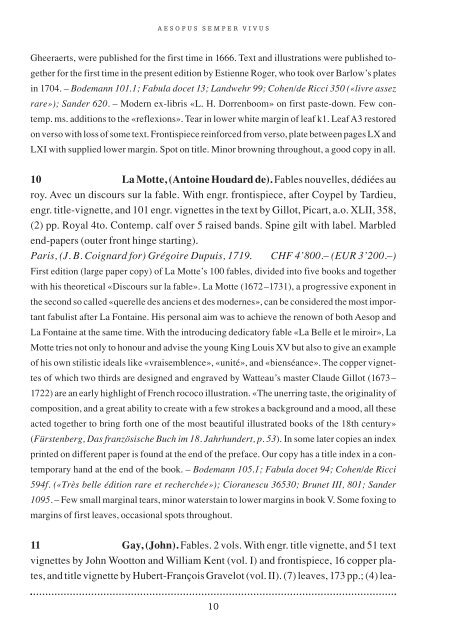FINE BOOK # 4 Aesopus semper vivus - Peter Bichsel · Fine Books
FINE BOOK # 4 Aesopus semper vivus - Peter Bichsel · Fine Books
FINE BOOK # 4 Aesopus semper vivus - Peter Bichsel · Fine Books
Create successful ePaper yourself
Turn your PDF publications into a flip-book with our unique Google optimized e-Paper software.
A E S O P U S S E M P E R V I V U S<br />
Gheeraerts, were published for the first time in 1666. Text and illustrations were published together<br />
for the first time in the present edition by Estienne Roger, who took over Barlow’s plates<br />
in 1704. – Bodemann 101.1; Fabula docet 13; Landwehr 99; Cohen/de Ricci 350 («livre assez<br />
rare»); Sander 620. – Modern ex-libris «L. H. Dorrenboom» on first paste-down. Few contemp.<br />
ms. additions to the «reflexions». Tear in lower white margin of leaf k1. Leaf A3 restored<br />
on verso with loss of some text. Frontispiece reinforced from verso, plate between pages LX and<br />
LXI with supplied lower margin. Spot on title. Minor browning throughout, a good copy in all.<br />
10 La Motte, (Antoine Houdard de). Fables nouvelles, dédiées au<br />
roy. Avec un discours sur la fable. With engr. frontispiece, after Coypel by Tardieu,<br />
engr. title-vignette, and 101 engr. vignettes in the text by Gillot, Picart, a.o. XLII, 358,<br />
(2) pp. Royal 4to. Contemp. calf over 5 raised bands. Spine gilt with label. Marbled<br />
end-papers (outer front hinge starting).<br />
Paris, (J. B. Coignard for) Grégoire Dupuis, 1719. CHF 4’800.– (EUR 3’200.–)<br />
First edition (large paper copy) of La Motte’s 100 fables, divided into five books and together<br />
with his theoretical «Discours sur la fable». La Motte (1672–1731), a progressive exponent in<br />
the second so called «querelle des anciens et des modernes», can be considered the most important<br />
fabulist after La Fontaine. His personal aim was to achieve the renown of both Aesop and<br />
La Fontaine at the same time. With the introducing dedicatory fable «La Belle et le miroir», La<br />
Motte tries not only to honour and advise the young King Louis XV but also to give an example<br />
of his own stilistic ideals like «vraisemblence», «unité», and «bienséance». The copper vignettes<br />
of which two thirds are designed and engraved by Watteau’s master Claude Gillot (1673–<br />
1722) are an early highlight of French rococo illustration. «The unerring taste, the originality of<br />
composition, and a great ability to create with a few strokes a background and a mood, all these<br />
acted together to bring forth one of the most beautiful illustrated books of the 18th century»<br />
(Fürstenberg, Das französische Buch im 18. Jahrhundert, p. 53). In some later copies an index<br />
printed on different paper is found at the end of the preface. Our copy has a title index in a contemporary<br />
hand at the end of the book. – Bodemann 105.1; Fabula docet 94; Cohen/de Ricci<br />
594f. («Très belle édition rare et recherchée»); Cioranescu 36530; Brunet III, 801; Sander<br />
1095. – Few small marginal tears, minor waterstain to lower margins in book V. Some foxing to<br />
margins of first leaves, occasional spots throughout.<br />
11 Gay, (John). Fables. 2 vols. With engr. title vignette, and 51 text<br />
vignettes by John Wootton and William Kent (vol. I) and frontispiece, 16 copper plates,<br />
and title vignette by Hubert-François Gravelot (vol. II). (7) leaves, 173 pp.; (4) lea-<br />
10



